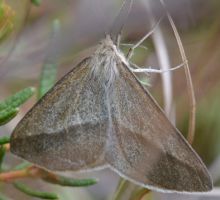

 +3Kontinente:EUASNA
+3Kontinente:EUASNA1. Lebendfotos
1.1. Falter
3. Weitere Informationen
3.1. Andere Kombinationen
- Aspilates forbesi Munroe, 1963 [Originalkombination]
3.2. Faunistik
Nach der [Fauna Europaea] kommt die Art in der Polarregion des Uralgebirges vor. Nach Skou & Sihvonen (2015) wurde sie dort in einem Torfmoor in 200 m Höhe gefunden. Die Art ist ansonsten holarktisch verbreitet, wird also nicht nur in Sibirien sondern auch im Norden Kanadas gefunden. Von dort (Churchill (Manitoba) am SW-Rand der Hudson Bay) wurde die Art auch beschrieben.
(Autor: Erwin Rennwald)
3.3. Typenmaterial
Munroe (1963: 272): “Holotype, male, and allotype, female, Churchill, Man., July 17, 1933, A. T. Harper.
Paratypes, 18 males, 14 females, from the following localities:—Manitoba: Churchill; Eastern Creek, near Churchill; Fort Churchill; Northwest Territories: Geillini Lake, 60°, 18'N., 95°, 35'W.; Bathurst Inlet; Yukon Territory: Rampart House; Alaska: Miles 213 and 249, Richards Highway; King Salmon, Naknek R.; Kotzebue.
Type No. 8051, C.N.C.; the Kotzebue paratype in the American Museum of Natural History, New York.”
3.4. Literatur
- Erstbeschreibung: Munroe, E. (1963): The gilvarius Group of Aspilates Treitschke (Lepidoptera: Geometridae). — The Canadian Entomologist 95 (3): 260-287.
- Skou, P. & P. Sihvonen (2015): The Geometrid Moths of Europe [A. Hausmann (ed.)]. Volume 5. Subfamily Ennominae I (Abraxini, Apeirini, Baptini, Caberini, Campaeini, Cassymini, Colotoini, Ennomini, Epionini, Gnophini (part), Hypochrosini, Lithinini, Macariini, Prosopolophini, Theriini and 34 species of uncertain tribus association). - 657 S.; (Brill) Leiden.




